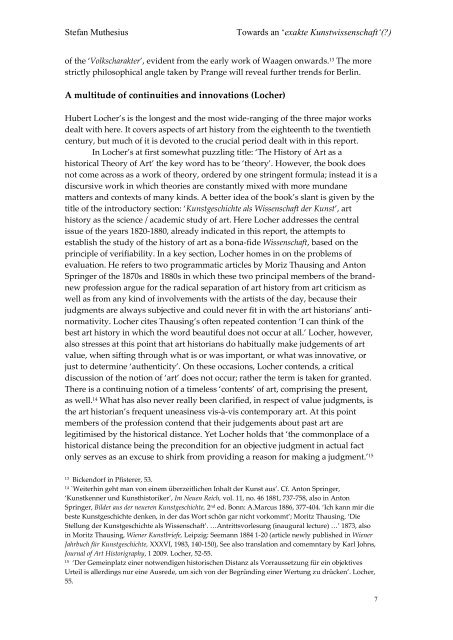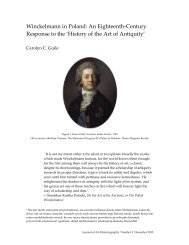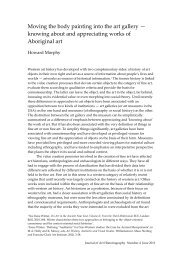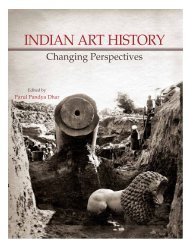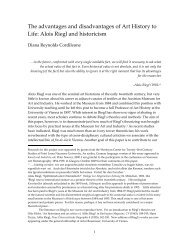9/SM1 - Journal of Art Historiography
9/SM1 - Journal of Art Historiography
9/SM1 - Journal of Art Historiography
You also want an ePaper? Increase the reach of your titles
YUMPU automatically turns print PDFs into web optimized ePapers that Google loves.
Stefan Muthesius<br />
Towards an ‘exakte Kunstwissenschaft‘(?)<br />
<strong>of</strong> the ‘Volkscharakter’, evident from the early work <strong>of</strong> Waagen onwards. 13 The more<br />
strictly philosophical angle taken by Prange will reveal further trends for Berlin.<br />
A multitude <strong>of</strong> continuities and innovations (Locher)<br />
Hubert Locher’s is the longest and the most wide-ranging <strong>of</strong> the three major works<br />
dealt with here. It covers aspects <strong>of</strong> art history from the eighteenth to the twentieth<br />
century, but much <strong>of</strong> it is devoted to the crucial period dealt with in this report.<br />
In Locher’s at first somewhat puzzling title: ‘The History <strong>of</strong> <strong>Art</strong> as a<br />
historical Theory <strong>of</strong> <strong>Art</strong>’ the key word has to be ‘theory’. However, the book does<br />
not come across as a work <strong>of</strong> theory, ordered by one stringent formula; instead it is a<br />
discursive work in which theories are constantly mixed with more mundane<br />
matters and contexts <strong>of</strong> many kinds. A better idea <strong>of</strong> the book’s slant is given by the<br />
title <strong>of</strong> the introductory section: ‘Kunstgeschichte als Wissenschaft der Kunst’, art<br />
history as the science / academic study <strong>of</strong> art. Here Locher addresses the central<br />
issue <strong>of</strong> the years 1820-1880, already indicated in this report, the attempts to<br />
establish the study <strong>of</strong> the history <strong>of</strong> art as a bona-fide Wissenschaft, based on the<br />
principle <strong>of</strong> verifiability. In a key section, Locher homes in on the problems <strong>of</strong><br />
evaluation. He refers to two programmatic articles by Moriz Thausing and Anton<br />
Springer <strong>of</strong> the 1870s and 1880s in which these two principal members <strong>of</strong> the brandnew<br />
pr<strong>of</strong>ession argue for the radical separation <strong>of</strong> art history from art criticism as<br />
well as from any kind <strong>of</strong> involvements with the artists <strong>of</strong> the day, because their<br />
judgments are always subjective and could never fit in with the art historians’ antinormativity.<br />
Locher cites Thausing’s <strong>of</strong>ten repeated contention ‘I can think <strong>of</strong> the<br />
best art history in which the word beautiful does not occur at all.’ Locher, however,<br />
also stresses at this point that art historians do habitually make judgements <strong>of</strong> art<br />
value, when sifting through what is or was important, or what was innovative, or<br />
just to determine ‘authenticity’. On these occasions, Locher contends, a critical<br />
discussion <strong>of</strong> the notion <strong>of</strong> ‘art’ does not occur; rather the term is taken for granted.<br />
There is a continuing notion <strong>of</strong> a timeless ‘contents’ <strong>of</strong> art, comprising the present,<br />
as well. 14 What has also never really been clarified, in respect <strong>of</strong> value judgments, is<br />
the art historian’s frequent uneasiness vis-à-vis contemporary art. At this point<br />
members <strong>of</strong> the pr<strong>of</strong>ession contend that their judgements about past art are<br />
legitimised by the historical distance. Yet Locher holds that ‘the commonplace <strong>of</strong> a<br />
historical distance being the precondition for an objective judgment in actual fact<br />
only serves as an excuse to shirk from providing a reason for making a judgment.’ 15<br />
13<br />
Bickendorf in Pfisterer, 53.<br />
14<br />
`Weiterhin geht man von einem überzeitlichen Inhalt der Kunst aus’. Cf. Anton Springer,<br />
‘Kunstkenner und Kunsthistoriker’, Im Neuen Reich, vol. 11, no. 46 1881, 737-758, also in Anton<br />
Springer, Bilder aus der neueren Kunstgeschichte, 2 nd ed. Bonn: A.Marcus 1886, 377-404. ‘Ich kann mir die<br />
beste Kunstgeschichte denken, in der das Wort schön gar nicht vorkommt’; Moritz Thausing, ‘Die<br />
Stellung der Kunstgeschichte als Wissenschaft’. …Antrittsvorlesung (inaugural lecture) …’ 1873, also<br />
in Moritz Thausing, Wiener Kunstbriefe, Leipzig: Seemann 1884 1-20 (article newly published in Wiener<br />
Jahrbuch für Kunstgeschichte, XXXVI, 1983, 140-150), See also translation and comemntary by Karl Johns,<br />
<strong>Journal</strong> <strong>of</strong> <strong>Art</strong> Historigraphy, 1 2009. Locher, 52-55.<br />
15<br />
‘Der Gemeinplatz einer notwendigen historischen Distanz als Vorraussetzung für ein objektives<br />
Urteil is allerdings nur eine Ausrede, um sich von der Begründing einer Wertung zu drücken’. Locher,<br />
55.<br />
7


